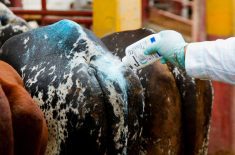“Several nonsubstantial changes” in the U.S. Department of Agriculture’s BSE regulations will slightly loosen a few remaining export restrictions on Canadian cattle and related products.
USDA on Friday announced amendments to its regulations on imports of animals and animal products from regions of “minimal risk” for BSE, or mad cow disease. USDA’s minimal-risk designation currently applies only to Canada, which has found 11 domestic cases of the disease in cattle since 2003.
The amendments, published Jan. 18, are to take effect Feb. 18. They include:
- allowing imports of “nonruminant material” processed in Canadian facilities that also process material from Canadian ruminants;
- allowing the individual identification of imported animals by means other than ear tags, as long as USDA’s Animal and Plant Health Inspection Service (APHIS) approves the ID method for the type of animal in question and the ID is traceable to the animal’s farm of origin; and
- opening the border to imports of gelatin made from cattle hides for any use, under certain conditions, in addition to the previously-allowed bone-derived gelatin.
Read Also

U.S. livestock: Cattle futures slow descent
Chicago cattle futures fell on Thursday but to a lesser degree compared to Wednesday’s limit-down drop. Most-active December live cattle…
APHIS said in a release Friday that the restrictions to be loosened next month provide “no additional safeguards against the introduction of BSE into the United States.”
The U.S. has reported just three domestic cases of BSE in cattle, between 2003 and 2006. The first of those, found in Washington state in late 2003, came from a Canadian herd and is considered by the World Organization for Animal Health (OIE) to be Canada’s 12th case.













